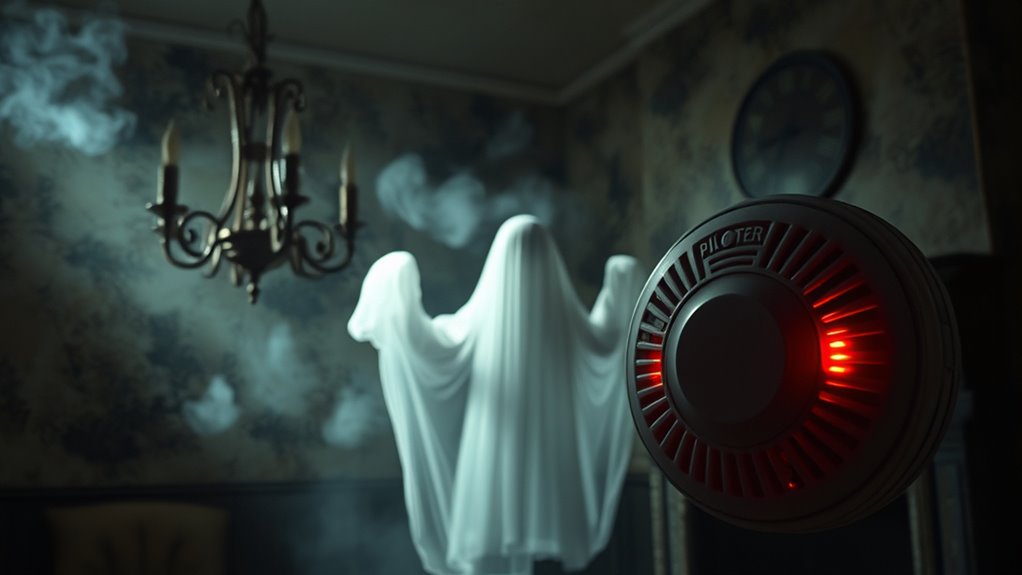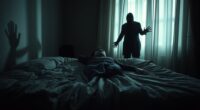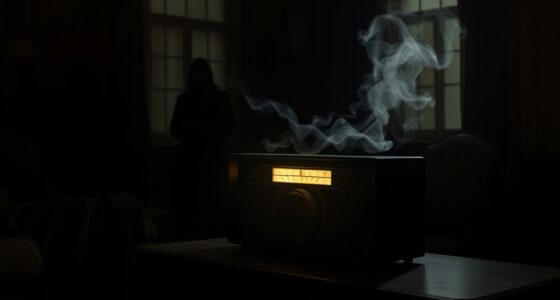Yes, there’s a link between carbon monoxide (CO) and ghost sightings. CO is an odorless gas that can cause symptoms like headaches, dizziness, and confusion, often mistaken for paranormal experiences. Historical cases show that many hauntings coincided with CO exposure due to faulty appliances. Modern investigations confirm homes with reported ghost activity often have CO leaks. Understanding this connection can help demystify such encounters and improve safety in your home, leading to more intriguing insights on this topic.
Key Takeaways
- Carbon monoxide (CO) is a colorless, odorless gas that can cause symptoms mimicking paranormal experiences, such as headaches and dizziness.
- Historical cases link CO exposure to ghostly encounters, with reports of hauntings often coinciding with faulty heating systems.
- Auditory hallucinations associated with CO poisoning have been misinterpreted as supernatural phenomena throughout history.
- Modern investigations show homes with reported paranormal activity frequently have CO leaks, suggesting a connection between the two.
- Preventing CO poisoning through detectors and regular maintenance is crucial for distinguishing between real dangers and misinterpreted supernatural experiences.
Understanding Carbon Monoxide: The Invisible Threat

Understanding carbon monoxide is essential, especially since it’s an invisible threat that can silently infiltrate your home. This colorless, odorless gas is produced through the incomplete combustion of fuels, making it undetectable without proper equipment.
When inhaled, it binds to hemoglobin in your blood with a much greater affinity than oxygen, leading to reduced oxygen delivery to your body tissues. This can result in serious health effects, including carbon monoxide poisoning. Symptoms like headaches, dizziness, and confusion might even be misinterpreted as supernatural experiences.
Chronic exposure can lead to personality changes and paranoia, further complicating the situation. To protect yourself, guarantee proper ventilation and functioning carbon monoxide detectors are in place, as even small leaks can have significant consequences.
Symptoms of Carbon Monoxide Poisoning vs. Paranormal Experiences

When you experience symptoms like headaches or dizziness, it’s easy to jump to conclusions about paranormal activity.
However, these signs often overlap with carbon monoxide poisoning, raising questions about what’s really happening in seemingly haunted spaces.
Exploring historical cases and environmental factors can help clarify the blurred lines between ghostly encounters and health risks.
Overlapping Symptoms Identified
Although the idea of encountering a ghost can be thrilling, many people experiencing such phenomena may actually be suffering from carbon monoxide (CO) poisoning. The symptoms of carbon monoxide—like headaches, dizziness, and confusion—mirror those often reported during paranormal experiences.
You might feel a haunting presence or even dread, pressure on your chest, and hallucinations, which complicates distinguishing between the two. Historical cases, such as the 1921 family reporting ghostly apparitions, were later linked to CO exposure from a faulty furnace.
Modern examples, like Carrie Poppy’s experience, show auditory hallucinations and feelings of being watched can stem from CO leaks rather than supernatural causes, blurring the lines between reality and the paranormal in ghost sightings.
Environmental Influences Explored
As you explore the domain of ghost sightings, consider how environmental factors, particularly carbon monoxide exposure, can shape your perceptions. Symptoms like headaches, dizziness, and even hallucinations often overlap with reported paranormal experiences, leading to potential misinterpretations.
For example, the pressure on your chest and confusion you might feel could mimic sensations during haunting experiences. Historical cases reveal that families, believing they encountered ghosts, were actually suffering from carbon monoxide exposure due to faulty heating systems.
Modern stories, like Carrie Poppy’s, illustrate how feelings of dread stem from carbon leaks rather than supernatural causes. The increase in ghost sightings during the Victorian era may also tie back to widespread carbon gas exposure, influencing cultural views on hauntings.
Historical Cases Analyzed
Many historical cases illustrate how symptoms of carbon monoxide poisoning can easily be mistaken for paranormal experiences. For instance, in 1921, a family reported ghostly apparitions due to a malfunctioning furnace. This is just one of many instances where the overlap is evident:
- Auditory hallucinations often mistaken for voices or whispers.
- Dizziness and headaches misinterpreted as spiritual disturbances.
- A sense of being watched linked to the effects of poisoning.
- Increased reports of hauntings during the Victorian era, likely influenced by gas appliances.
These examples show how carbon monoxide poisoning can create experiences that seem supernatural. It’s essential to take into account these symptoms before jumping to conclusions about hauntings.
Historical Cases Linking Carbon Monoxide to Hauntings
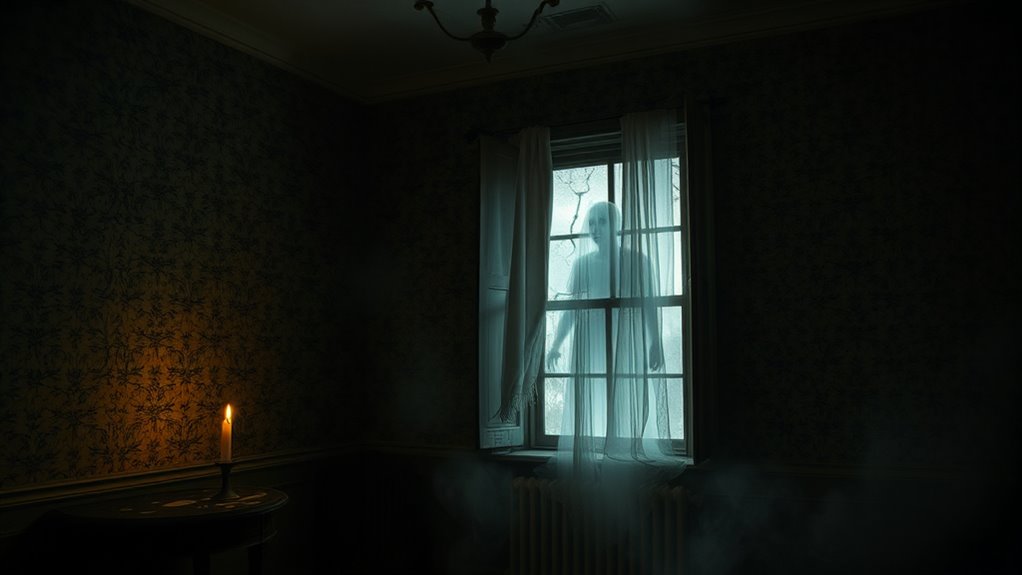
You might be surprised to learn that many historical cases of hauntings can actually be traced back to carbon monoxide exposure.
From the Victorian era’s fascination with the paranormal to early 20th-century reports of eerie experiences, these incidents often had a rational explanation.
Let’s explore how these accounts intertwine with carbon monoxide poisoning, revealing a different side of ghostly encounters.
Early 20th Century Reports
While ghost sightings have long captivated the imagination, early 20th-century reports reveal a troubling link between these experiences and carbon monoxide poisoning.
You might be surprised to learn that many haunted houses had underlying issues contributing to these eerie encounters.
Consider these key points:
- A 1921 report connected a family’s ghostly apparitions to carbon monoxide from a faulty furnace, causing hallucinations and health problems.
- Mrs. H’s case showed auditory and visual hallucinations attributed to CO exposure, not supernatural forces.
- Common symptoms like dread and the sensation of being watched often matched the effects of CO poisoning.
- A 1912 case highlighted how malfunctioning furnaces led to mistaken paranormal experiences.
These historical examples suggest many hauntings might stem from environmental factors instead of the supernatural.
Victorian Era Experiences
The Victorian era is often romanticized for its fascination with the supernatural, but a closer look reveals that many ghost sightings during this time were likely linked to carbon monoxide exposure from faulty heating systems.
Homes relied heavily on coal gas, which emitted high levels of carbon monoxide, often leading to poorly ventilated spaces. A notable 1921 case involved a family experiencing ghostly apparitions attributed to a defective furnace, causing hallucinations and fatigue in the children.
The psychological effects of carbon monoxide, including confusion and hallucinatory experiences, likely fueled the rise of ghost stories and Gothic horror literature.
Investigations into reported hauntings frequently uncovered that these sensations stemmed from CO poisoning rather than actual supernatural occurrences, highlighting environmental factors in these historical accounts.
Modern Case Studies
As researchers explore modern case studies, they often uncover unsettling evidence linking carbon monoxide exposure to reported hauntings.
Here are some notable examples:
- In 1921, a family’s ghostly apparitions were traced to carbon monoxide poisoning from a faulty furnace, causing hallucinations and health issues.
- Investigative journalist Carrie Poppy experienced auditory hallucinations linked to a carbon monoxide leak in her home.
- Many Victorian-era ghost sightings may have originated from chronic exposure to coal gas, which contains high levels of carbon monoxide.
- A haunting in a Boston house revealed sensations of oppression, caused by defective furnace gases leaking into the living space.
These cases suggest that what you might think is an otherworldly encounter could actually stem from carbon monoxide, leading you to experience ghostly sensations.
Modern Examples: Ghostly Encounters and CO Exposure

Many people may not realize that what they perceive as ghostly encounters could actually stem from carbon monoxide exposure. Modern examples show that symptoms like auditory hallucinations and feelings of dread often correlate with carbon monoxide poisoning. Investigations reveal that homes with reported paranormal activity frequently have CO leaks. Carrie Poppy’s case highlights this, where her haunting sensations were linked to a dangerous gas leak.
| Symptoms | Potential Cause |
|---|---|
| Auditory Hallucinations | Carbon Monoxide Exposure |
| Confusion | Carbon Monoxide Exposure |
| Feelings of Dread | Carbon Monoxide Exposure |
| Chest Pressure | Carbon Monoxide Exposure |
Awareness of these links can help demystify ghost sightings and prioritize the need for environmental assessments over supernatural explanations.
Preventing Carbon Monoxide Poisoning in Your Home

To keep your home safe from carbon monoxide poisoning, proactive measures are essential.
Here are four steps you can take to prevent carbon monoxide poisoning:
- Install carbon monoxide detectors outside each sleeping area and on every floor to provide early warning of dangerous CO levels.
- Schedule professional maintenance for your heating systems every fall, ensuring proper ventilation and preventing CO leaks.
- Test CO alarms monthly and replace them according to the manufacturer’s instructions to keep them functioning properly.
- Change air filters every 30-60 days to maintain good airflow and reduce the risk of CO buildup.
The Cultural Impact of CO Poisoning on Supernatural Beliefs
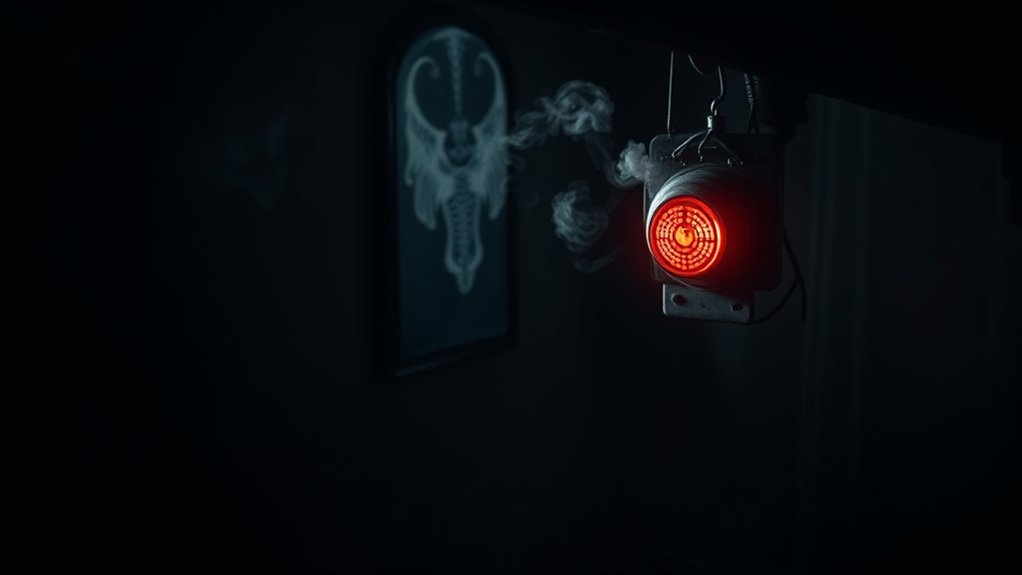
Understanding the risks of carbon monoxide poisoning not only protects you but also sheds light on its intriguing historical impact on cultural beliefs.
In the Victorian era, chronic exposure to this odorless gas from common sources like coal gas may have sparked a rise in ghost stories and haunting beliefs. Symptoms of CO poisoning, such as hallucinations and dread, were often misinterpreted as supernatural encounters, as illustrated by the 1921 case of Mrs. H.
Chronic exposure to carbon monoxide in the Victorian era may have fueled ghost stories, intertwining health symptoms with supernatural beliefs.
Gothic Horror literature, including works by Edgar Allan Poe, drew inspiration from these psychological effects, fueling paranoia and vivid imagery.
This intersection of science and folklore reveals how environmental factors like CO exposure shaped societal fears and beliefs about the supernatural, blending reality with imagination.
Frequently Asked Questions
Can Carbon Monoxide Make You See Ghosts?
Yes, carbon monoxide can cause symptoms that might make you feel like you’re seeing ghosts.
It can lead to hallucinations, confusion, and a sense of dread, which can easily be misinterpreted as supernatural experiences.
If you’re in an environment with high levels of carbon monoxide, you might mistake these symptoms for ghostly encounters.
It’s essential to guarantee proper ventilation and monitor for CO to avoid these unsettling experiences.
Always prioritize safety!
What Causes Ghost Sightings?
Ghost sightings often emerge from the shadows of our fears and imagination, weaving tales of the unknown.
When you experience a ghost sighting, it might stem from sleep disturbances, psychological stress, or even environmental triggers like low light and eerie sounds. Your mind can transform ordinary moments into supernatural events.
Sometimes, it’s just a trick of the light or a fleeting shadow, reminding you that reality can be as mysterious as the supernatural.
What Are Two Warning Signs of Carbon Monoxide?
Two key warning signs of carbon monoxide poisoning you should watch for are persistent headaches and dizziness.
You might mistake these symptoms for something else, but they can indicate dangerous CO exposure.
Additionally, if you feel confusion or weakness, it’s essential to act quickly.
These signs often escalate, so don’t ignore them.
If you notice any of these symptoms, check your appliances and guarantee proper ventilation immediately.
Your safety depends on it.
Does Carbon Dioxide Poisoning Cause Hallucinations?
Where there’s smoke, there’s fire, and when it comes to carbon dioxide poisoning, hallucinations can indeed occur.
You might experience confusion, dizziness, or even visual disturbances if exposed to high levels of CO2. However, it’s more commonly associated with asphyxiation rather than outright hallucinations.
Always be cautious about air quality in enclosed spaces, as poor ventilation can lead to dangerous levels of carbon dioxide, affecting your health and mental clarity.
Conclusion
In the end, the link between carbon monoxide and ghost sightings can’t be ignored. Just like a thick fog that creeps in unnoticed, CO can cloud your mind, causing confusion and fear that mimic paranormal experiences. Imagine a family, convinced their home is haunted, only to discover that a faulty furnace was the true culprit. By staying vigilant and ensuring proper ventilation, you can clear the air—both literally and figuratively—protecting your home from invisible threats and unwelcome hauntings.
